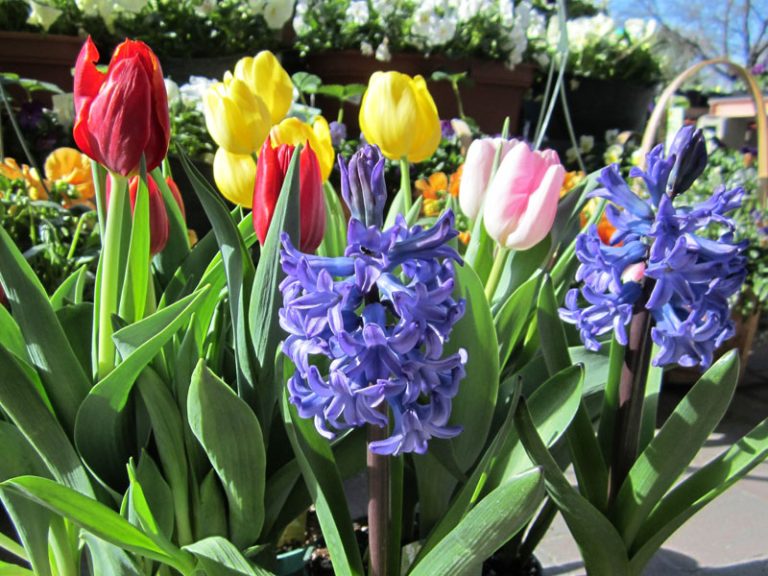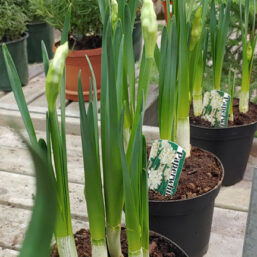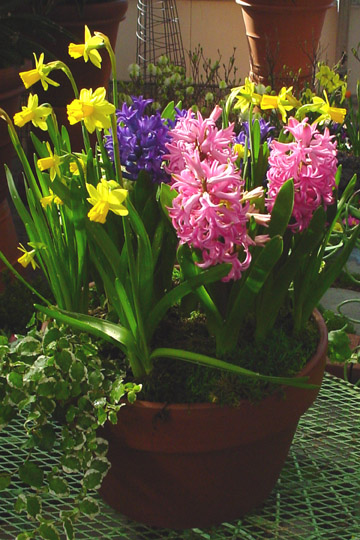Forcing Bulbs into Bloom

A Fun Experiment to Enjoy Spring Early
Spring flowering bulbs usually need a rooting period of 12 to 15 weeks at temperatures between 41-48°F to produce a good root system. That’s essential to be “forced” into flower. Commonly forced bulb flowers are amaryllis, paper-white narcissus, muscari and hyacinths. Certainly they are the easiest. However, colchicum and miniature iris will flower through forcing as well.
This timetable: Bulb Chilling Times for Indoor Forcing will help you plan a forcing schedule to have flowers at a given date. Remember that these can vary, and in all cases, only well-rooted bulbs produce good flowers.
- To flower in January, plant in September or very early October
- To flower in February, plant early- to mid-October
- To flower later, plant in late October or early November
Exceptions: amaryllis (Hippeastrum) and paperwhites (Narcissus papyraceus) arrive dormant at the Garden Center and are ready to force into bloom.
Storing Bulbs
If you can’t pot them right away, bare bulbs will store for several weeks if they are packed properly and put in your refrigerator before potting up. However, don’t keep bulbs in the same drawer where you keep ripening fruit or vegetables. They give off ethylene gas which can harm the bulbs. (Also some bulbs are poisonous. NOT a method recommended for households with young children.) Bulbs will still require a cool-temperature rooting period after potting.
For best storing, pack bulbs in a mesh bag or paper bag with holes that permit ventilation. You don’t have to worry about water, as the humidity inside a refrigerator is usually high enough. Check them periodically to make sure they haven’t dried out or grown moldy.
If Possible, Start Potting Bulbs Immediately for Cooling/Rooting
Pot your bulbs right away if you have a cool location immediately available such as an old (functioning) refrigerator, a root cellar or cool basement; or if outdoor temperatures are below 45°F. Your refrigerator can serve as a suitable rooting area if you have the pot space.
- Use clean pots with drainage holes (the depth will depend on the bulbs being grown). Size of pot depends on the bulb size. Allow for 2 inches of soil below the bulb and select a pot large enough to allow the top of the bulb to be even with the rim when placed on the soil. Different types of bulbs require differing periods of time to root well. For this reason, it is not advisable to combine different types of bulbs in the same pot.
- Plain potting soil is fine. You can add some bone meal or special fertilizer formulated for bulbs, just a “pinch” per bulb, to the soil mixture.
- Place 2 inches of soil in the pot, then gently place bulbs into position. Add enough soil to fill the pot, firming the soil gently around the bulbs being careful not to bruise them. Water well in order to settle the soil around the bulbs. Bulbs can be planted very close together, even touching, and make the best show in “crowded” arrangements.
- Label each pot with the name of the variety, planting date, and the date you intend to bring it out of storage for forcing. Bulbs will flower some 3-4 weeks after they have been brought into warmer temperatures. Thus, from time of planting to flowering, allow a period of 15 weeks–12 weeks for rooting and 3 weeks in warmer temperatures to flower. It is easier to hold bulbs back than to speed them up, so when you know the date you want them to be in flower, calculate accordingly the best planting time. For Valentine’s Day flowers, for example, plant bulbs in early- to mid-October.
Once Chilled, Force Blooms with Heat
The actual forcing begins at the stage when you remove the bulbs from the root-growing environment into warmth and light, triggering the growth of leaves and flowers. Sunshine and temperature are the most important factors in promoting successful flowering. Most bulbs will require about 3 or 4 weeks from the time they are removed from cold storage before they bloom.
- After the rooting period, transfer the pots to a place indoors with indirect sunlight and temperatures about 60°F for a week or two.
- When the shoots are 4-6 inches tall, move the pots to a bright, sunny window to stimulate blooming. A temperature of about 68°F and direct sunlight will produce the best results.
- When the buds take on color, return the plants to indirect sunlight to make the blossoms last. Keep the soil moist at all times.
Pots can be moved!
- If blossoms begin to develop too quickly, you may be able to retard blooming a bit by moving the pots out of direct sunlight and into a cooler location. Move them back to sunlight and warmer temperatures when you want them to resume growing.
After blooming, discard hardy bulbs such as hyacinths and tulips. Or plant them outdoors where they may rebloom within a year or two.
NO-CHILL, Easy Paperwhite Narcissus
Popular paperwhites (narcissus tazetta), ‘Soleil d’Or’, ‘Chinese sacred lily’ and colchicum don’t require the 12-week rooting period. They can give you indoor blooms from Thanksgiving until late March, if planted successively, batch after batch in late fall. Pot paperwhites easily in shallow containers of gravel. See simple detailed steps with this link.
The Easiest Bulbs for Forcing
- paperwhite narcissus; popular bulb; grows in soil or gravel
- amaryllis; popular Christmas plant (plant bulb in early November, no cooling necessary)
- large-flowering crocus; requires 12-14 week rooting period; pot in gravel and water for a different effect
- hyacinth; fragrant spring-time favorite; requires about 12 weeks for rooting; force in special “hyacinth” vases using only water
- colchicum; excellent for forcing, can even grow on a window sill without soil or water; begins blooming in about two weeks
- muscari; requires 16 week rooting time; pot plenty, they’re small
- iris; especially iris reticulata are easy to force, but need careful attention to drainage; require about 15 weeks for rooting; don’t hold iris bulbs too long before potting; tall-stemmed iris are less suited to forcing
Other Bulbs for Forcing
- Forced tulips require a fairly long rooting period at a constant temperature to be successful. Allow at least 15 weeks. Experiment with a few pots of different varieties. Tulip Tip: Plant bulbs with flat side facing the rim, this will position the larger outer leaves toward the pot rim, where they will drape gracefully over the edge of the pot.
- Daffodils require very bright light, such as that found in a greenhouse, to flower well. Too little sun results in leggy growth and no blossoms. Only the miniature varieties (hybrid) daffodils work well for home forcing. Daffodils usually require a 12-14 week rooting period. Once rooted, place daffodils in a location that receives a full day of sun, say an enclosed porch or sun room or under a skylight.
Our Summer Garden Advice
By mid-summer, perennial gardens can start to look overgrown, annual flowers begin to fade, and bugs may be munching on your vegetables.
Summer Articles
